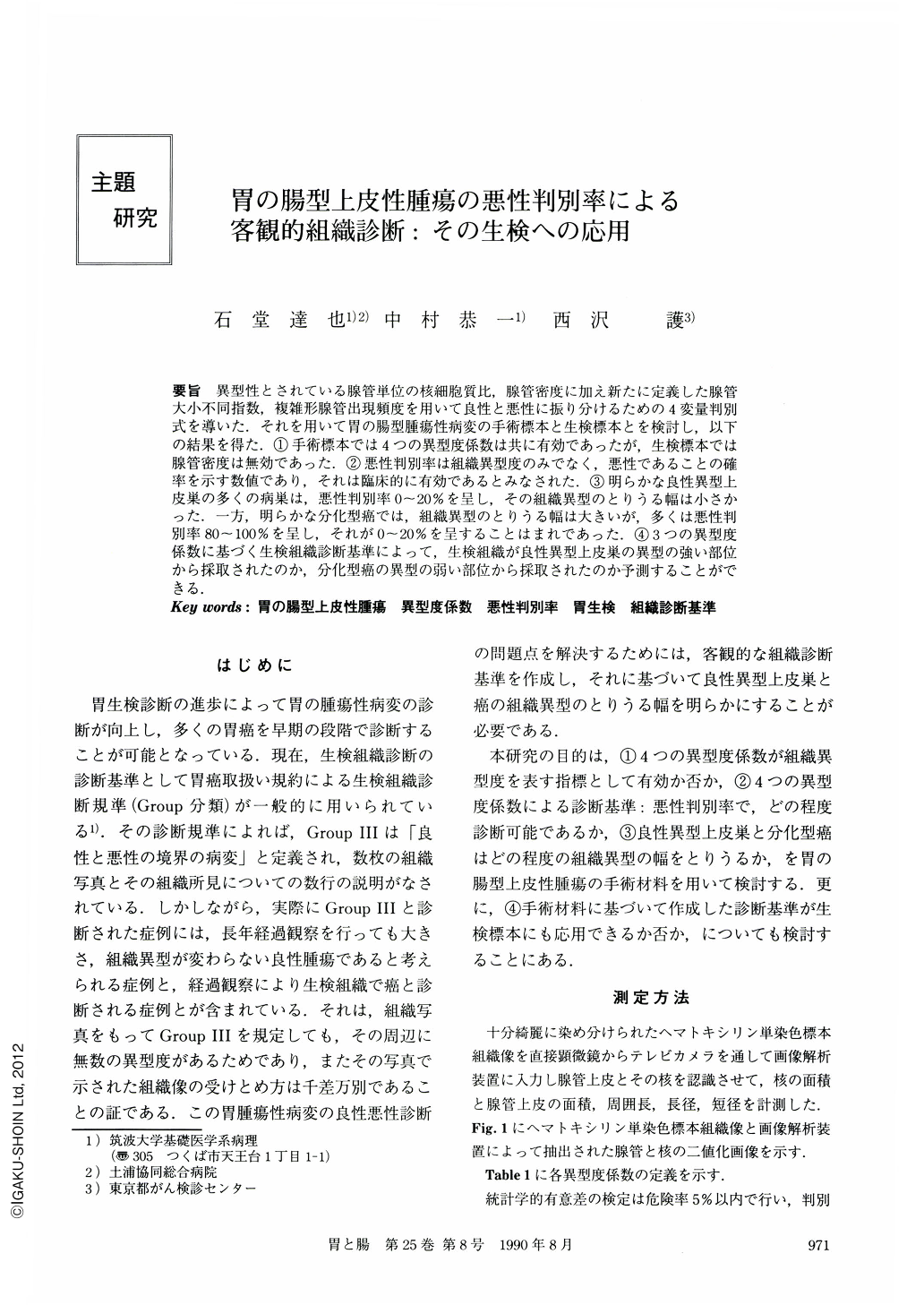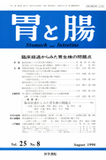Japanese
English
- 有料閲覧
- Abstract 文献概要
- 1ページ目 Look Inside
要旨 異型性とされている腺管単位の核細胞質比,腺管密度に加え新たに定義した腺管大小不同指数,複雑形腺管出現頻度を用いて良性と悪性に振り分けるための4変量判別式を導いた.それを用いて胃の腸型腫瘍性病変の手術標本と生検標本とを検討し,以下の結果を得た.①手術標本では4つの異型度係数は共に有効であったが,生検標本では腺管密度は無効であった.②悪性判別率は組織異型度のみでなく,悪性であることの確率を示す数値であり,それは臨床的に有効であるとみなされた.③明らかな良性異型上皮巣の多くの病巣は,悪性判別率0~20%を呈し,その組織異型のとりうる幅は小さかった.一方,明らかな分化型癌では,組織異型のとりうる幅は大きいが,多くは悪性判別率80~100%を呈し,それが0~20%を呈することはまれであった.④3つの異型度係数に基づく生検組織診断基準によって,生検組織が良性異型上皮巣の異型の強い部位から採取されたのか,分化型癌の異型の弱い部位から採取されたのか予測することができる.
In order to objectively differentiate adenocarcinoma from intestinal type adenoma of the stomach, a linear discriminant function was developed using four indices quantifying dgrees of histological atypicality. Based on that function a parameter was developed to indicate probability of malignancy. The indices employed here were defined as follows
Index of Nucleus-Glandular Ratio (ING)
ING = (Area of nuclei / Area of cytoplasm) per glands in unit area×100 (%)
Index of Tubular Density (ITD)
ITD = (Area of glands / Area of glands and stroma) per unit area×100 (%)
Index of Dispersion of Tubular Size (IDS)
IDS = (Standard deviation / Mean value) of Maximum width of tubulus in unit area×100 (%)
Degree of Complexity of Tubular Shape (DCT)
DCT= (Round factor of a tubulus / Round factor of an oval whose aspect ratio is the same as that of the tubulus) in unit area
Frequency of Complicated Tubuli in Shape (FCT)
FCT = (Number of the tubulus whose DCT value is higher than 1.5 / Total number of tubuli) in unit area×100 (%)
These indices were obtained by measuring and calculating intestinal type adenoma or adenocarcinoma surgically resected or surveyed for more than three years by biopsy using computed image analyser.
A linear discriminant function and critical values for discriminating malignancy from benignancy were obtained as shown in Table 4. Eighty-three percent of adenomas were classified into benignancy and 80% of adenocarcinomas into malignancy. However, discriminant scores on adenomas and those on adenocarcinomas overlapped significantly as shown in Fig. 5. Therefore, discrimination based on the function had to be probabilistically expressed for each score. The probability of malignancy was defined as the ratio of the num-ber of lesions of adenocarcinomas to the total number of lesions of adenomas and those of adenocarcinomas for a given discriminant score. Histograms of the probability of malignancy were depicted for both groups of cases, i.e., surgically resected and biopsied (Figs. 8 and 11). About 80% of adenomas exhibited the probability of malignancy 0 to 20% and the scores in these cases were distributed within narrow range. On the other hand, about 60% of adenocarcinomas exhibited the probability of malignancy 80 to 100%, and about 35 of adenocarcinomas did 20 to 80% of the probability of malignancy. The scores in these cases were distributed in wider range than those of adenomas.
Based on the probability of malignancy, biopsy specimen of intestinal type adenomas and adenocarcinomas of the stomach can be objectively diagnosed as follows: (1) If biopsy specimens in a given case exhibit the probability of malignancy 0 to 20%, then it may well be diagnosed as benign. (2) If biopsy specimens exhibit the probability of malignancy 20 to 80%, it is possible that it is malignant. (3) If biopsy specimens show the probability of malignancy over 80%, it can be diagnosed as malignant.

Copyright © 1990, Igaku-Shoin Ltd. All rights reserved.


